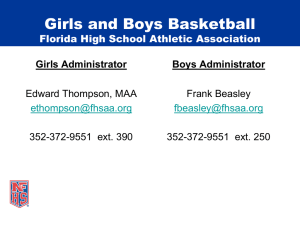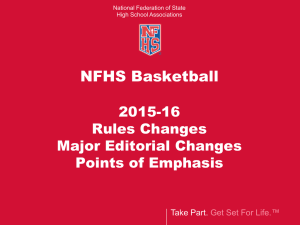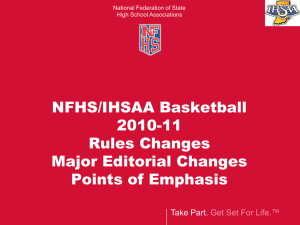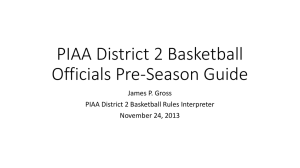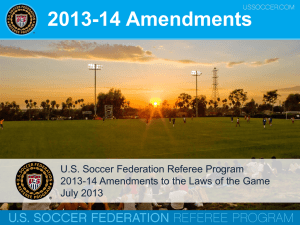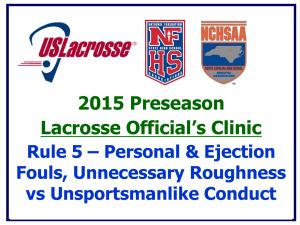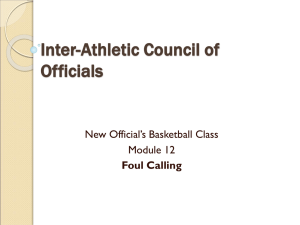2011-12NFHSBasketballRulesChanges
advertisement
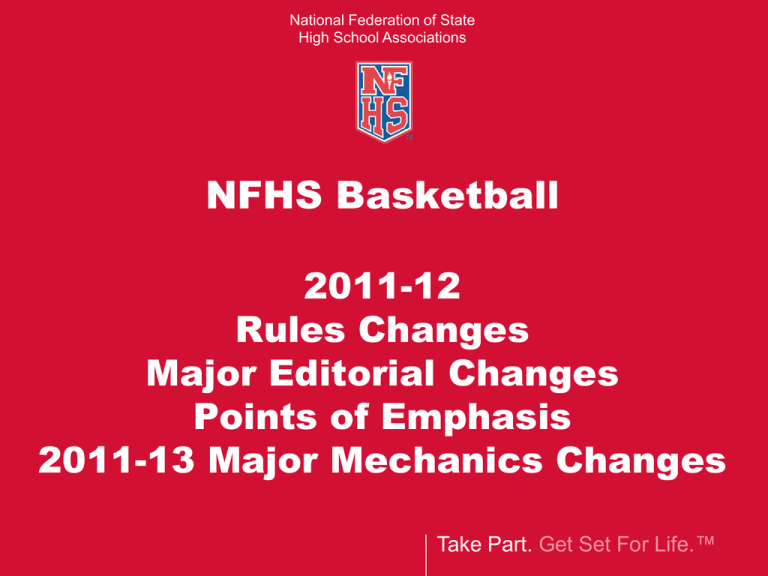
National Federation of State High School Associations NFHS Basketball 2011-12 Rules Changes Major Editorial Changes Points of Emphasis 2011-13 Major Mechanics Changes Take Part. Get Set For Life.™ Correction: 2011-13 Basketball Officials Manual Page 13, 1.4.1.B – Delete phrase “or throw-in,” from the first sentence. Fundamental did not get updated with this year’s rules change in the manual only. The same fundamental is correct in the 2011-12 Basketball Rules Book. National Federation of State High School Associations NFHS Basketball 2011-12 Rules Changes Take Part. Get Set For Life.™ CENTER CIRCLE LINE SPECIFICATIONS (1-3-1) Center restraining circle specifications were changed to permit a minimum of a ¼-inch-wide single line, but a line no wider than 2-inches, to designate the outer edge of the circle. The line must be continuous and clearly visible. CENTER CIRCLE LINE SPECIFICATIONS (1-3-1) Many existing courts already have a center circle that has a single ¼inch line. The committee believes this change will provide consistency in the rule. A mathematical line between two solid colors is still permitted. ARM COMPRESSION SLEEVE REQUIREMENTS (3-5-3) The specifications regarding arm compression sleeves were changed to require the item to be white, black, beige or a single solid school color. All arm compression sleeves worn: • Shall have only a single manufacturer’s logo that does not exceed 2¼ square inches. • Shall be the same color for each team member. • Need not be the same color as the headband/wristband color. ARM COMPRESSION SLEEVE REQUIREMENTS (3-5-3) Arm compression sleeves must still be worn for medical purposes. Under the previous rule, arm compression sleeves had no logo restrictions, could have been multiple colors and teammates could have worn a variety of different colors. This rules change provides clarification, makes enforcement more consistent for officials and enhances team uniformity. TEAM CONTROL DURING A THROW-IN (4-12-1, 2, 6) Several definitions were changed to reflect that team control will now exist during a throw-in when the thrower-in has the ball at his/her disposal. TEAM CONTROL DURING A THROW-IN (4-12-1, 2, 6) Under the previous rule, there was no team control during a throw-in. The penalty for a common foul committed by the throw-in team after the throw-in had begun resulted in free throws if the offended team was in the bonus. This was inconsistent with the penalty for a team-control foul in non-throw-in situations. TEAM CONTROL DURING A THROW-IN (4-12-1, 2, 6) The change primarily affects how foul penalties will be administered. By changing the definition of player and team control to include a throw-in, greater consistency in penalty administration for a common foul is achieved. The contest will also be expedited by eliminating the delay inherent with administering free throws. TEAM CONTROL DURING A THROW-IN (4-12-1, 2, 6) Only team-control fouls occurring during a throw-in were affected by this change. The change does NOT affect any of the following rules: • Three seconds in the lane • Traveling/Dribbling • Backcourt • Alternating-possession throw-in rules Minor edits occurred to some of these rules for clarification. National Federation of State High School Associations NFHS Basketball 2011-12 Major Editorial Changes Take Part. Get Set For Life.™ BASKET RING (1-11-2, 3) Updated specifications were added to the basket-ring rules. A note was also added recommending that basket rings be inspected for rules compliance. OFFICIALS’ JURISDICTION (2-2-4 New Note) A note was added clarifying the administrative responsibilities of game officials through the completion of required reports. This change was for administrative purposes only and does NOT affect officials’ jurisdiction rules. UNIFORMS (3-4-1c) A new note was added recommending that the visiting team’s dark jersey be the darker of the school’s color scheme or black. Light blue, light gold and light silver visiting uniforms continue to be problematic since they are difficult to differentiate from the home white jerseys. TEAM MEMBER’S EQUIPMENT, APPAREL (3-5-1 New Note ) A new note was added authorizing state associations to grant exceptions to NFHS playing rules for participants with disabilities, special needs and/or extenuating circumstances. INTENTIONAL FOUL (4-19-3) The definition of an intentional foul was clarified and reorganized to assist in identifying specific illegal acts. INTENTIONAL FOUL (4-19-3) ART. 3 . . . An intentional foul is a personal or technical foul that may or may not be premeditated and is not based solely on the severity of the act. Intentional fouls include, but are not limited to: • Contact that neutralizes an opponent's obvious advantageous position. • Contact away from the ball with an opponent who is clearly not involved with a play. • Contact that is not a legitimate attempt to play the ball/player specifically designed to stop the clock or keep it from starting. • Excessive contact with an opponent while playing the ball. • Contact with a thrower-in as in 9-2-10 Penalty 4. CHARGED TIME-OUT (5-11 & 12) The sections related to charged time-outs were consolidated and reorganized. Section 5-12 became unnecessary and was deleted. ALTERNATING POSSESSION (6-4-3e, g & Note) Alternating-possession throw-in situations were clarified. The point-of-interruption procedure in 4-36 made previous items e. and g. inaccurate. The existing Note was also edited to clarify the players that would be involved in a subsequent jump ball. RESUMING PLAY DIFFERENCES (8-6-2, 8-6-3 New, 8-7) Penalty administration was clarified when: • Single fouls occur as part of a multiple free-throw situation, and • A double foul occurs as part of a multiple free-throw situation. Based on these editorial changes, Section 8-7 became unnecessary and was deleted. THROW-IN PROVISIONS (9-2-10 Penalty 4) Clarified that when an opponent contacts the thrower-in, an intentional foul shall be charged to the offender. Any type of contact on a thrower is an intentional foul. The defender does not actually have to break the boundary plane. This clarification will assist in more consistent enforcement. National Federation of State High School Associations NFHS Basketball 2011-12 Points of Emphasis Take Part. Get Set For Life.™ SPORTING BEHAVIORS State administrators and the NFHS Basketball Rules Committee continue to be concerned about the following behaviors: PREGAME SITUATIONS Teams entering the gymnasium prior to the contest should not run through the area occupied by the opposing team or under the basket where opponents are warming up. Teams should only enter, jog or warmup on their own half of the court, when possible. PREGAME SITUATIONS Gatherings intended to motivate a team after the warm-up period, during or following player introductions and post-game celebrations should be performed in the area directly in front of the team bench. PREGAME SITUATIONS If during the pregame or halftime warmup period one team leaves the floor, the other team should not use the entire court; teams should only warm-up on their half of the court. Only authorized personnel should be permitted on the floor. All spectators should be in designated areas. TAUNTING/SELF PROMOTION Players are increasingly directing their celebratory actions toward opponents, which should be interpreted as taunting and baiting, and penalized accordingly. Further, the committee is concerned with the trend toward players "playing to the crowd," attempting to increase attention and praise for their own individual accomplishments rather than toward the game itself and team achievements. TAUNTING/SELF PROMOTION While many of these actions are not specifically illegal by rule, extreme behaviors could and should be considered taunting and baiting of the opponent. Officials should remind captains and head coaches at the pregame conference that all actions and reactions should demonstrate appropriate sporting behavior. GUIDELINES FOR TEACHING AND OFFICIATING The following guidelines are excerpts from past NFHS Points of Emphasis. The committee believes sharing these guidelines again will assist in game administration. HANDCHECKING/BODY FOULS Tactics using the hands, arms or body that permit any player (offense or defense) to "control" (hold, impede, push, divert, slow or prevent) the movement of an opposing player is a foul. When an offensive player uses the hands or body to push off for position or spacing to get open or receive a pass, or to move the ball via pass or dribble, it is a foul. HANDCHECKING/BODY FOULS “Hooking" by an offensive player is a distinct advantage. This tactic is not worthy of a warning and should be ruled a foul without hesitation. Any illegal use of hands, arms or body (offense or defense) that slows, prevents, impedes the progress or displaces an opposing player due to the contact, is a foul and must be called. HANDCHECKING/BODY FOULS Regardless of where it takes place on the court, when a player continuously places a hand on the ball handler/dribbler, it is a foul. When a player jabs a hand(s) or forearm on an opponent to control his or her movement or gain an advantage, it is a foul. SCREENING A legal screener must be stationary prior to contact with hands and arms close to the body. When these two requirements are not met, and when there is sufficient contact delivered by the screener to bump, slow or displace, it is a foul on the screener. SCREENING When screening a stationary opponent from behind (outside the visual field), the screener must allow the opponent one normal step backward without contact. When screening a moving opponent, the screener must allow the opponent time and distance to avoid contact by stopping or changing direction. SCREENING When a screen is set in view of an opposing player, the screener can get as close as he or she wishes in a legal stationary position. The burden is on the screened player to avoid contact that may result in a foul. To constitute a legal screen, the screener must stay within his or her vertical plane with a stance approximately shoulder-width apart. POST PLAY The offense may "shape up" to receive a pass or to force the defense to assume a legal guarding position at the side, in front or behind the offensive post player. POST PLAY When the offensive player then uses the "swim stroke," pushes, pins, elbows, forearms, holds, clears with the body, or just generally demonstrates rough physical movements or tactics, this is a foul on the offensive player and must be called without warning. POST PLAY The defense can assume a legal, vertical stance or position on the side, front or behind the offensive post player. When the defense undercuts (initiates lower-body non-vertical contact), slaps, pushes, holds, elbows, forearms or just generally demonstrates rough, physical movements or tactics, this is a foul on the defense and must be called without warning. POST PLAY When a player pushes a leg or knee into the rear of an opponent, it is a foul. When a player dislodges an opponent from an established position by pushing or "backing in," it is a foul. When a player uses hands, forearms or elbows to prevent an opponent from maintaining a legal position, it is a foul. REBOUNDING A player has a right to any spot on the court he or she may get to legally. To obtain or maintain a legal rebounding position a player may NOT: • Displace, charge or push an opponent. • Extend shoulders, hips or knees, or extend the arms or elbows fully or partially in a position other than vertical, so that the opponent's freedom of movement is hindered when contact occurs. REBOUNDING • Bend his or her body in an abnormal position to hold or displace an opponent. • Violate the principle of verticality. • Better his or her position by other than legal means. INJURY DATA AND PREVENTION The NFHS Sports Medicine Advisory Committee and NFHS sport committees use information from the National High School Sports-Related Injury Surveillance Study (High School RIO) to monitor rates and patterns of sports injuries among high school studentathletes. High School RIO is in its 6th year of collecting sports exposure and injury data. The most recent High School RIO report captured the following trends in boys and girls basketball. INJURY DATA – ANKLES A large portion of injuries for both boys and girls are ankle injuries (34.7% and 33.0% respectively). However, ankle injury rates have not significantly increased over time for either gender. The ankle injuries are most often occurring during rebounding activities for both boys and girls (43.3% and 31.4% respectively). INJURY DATA - CONCUSSIONS Concussion rates in boys’ and girls’ basketball have not significantly changed over time. However, boys are sustaining concussions more often during rebounding activities (28.5%) and girls during defending activities (26.5%) – both primarily due to player-to-player contact. INJURY DATA – ACL’S The incidence, rate and proportion of Anterior Cruciate Ligament (ACL) injuries to girls have not significantly changed over time. INJURY PREVENTION While the rules of the game can’t always prevent the types of injuries previously mentioned from occurring, coaches, players and officials all have an important role to play in keeping the risk of injury to a minimum. INJURY PREVENTION To assist in preventing injuries, the committee has addressed the following areas of concern: Coaches and officials must be able to recognize the signs and symptoms of a concussion, and be well versed in and follow NFHS and the respective state association concussion guidelines. INJURY PREVENTION There are several aspects of the game where injuries may be more likely to occur, but rebounding and defending were specifically noted in the injury data. Officials must adjudicate all rules as written, especially regarding illegal contact in those two areas. An airborne player is especially vulnerable to sustaining a serious injury with the slightest contact. INJURY PREVENTION Officials and coaches must be conscientious in protecting airborne players in the area of rebounding and shooting. Officials should not hesitate to rule a flagrant foul when “violent” contact occurs against an opponent, especially to the head. Officials must also remain diligent in ruling excessive swinging of the elbows, even when no contact occurs (violation). National Federation of State High School Associations NFHS Basketball 2011-13 Mechanics Changes Take Part. Get Set For Life.™ TRAIL MIRRORS CHOP SIGNAL (2.2.2.C.6 New) In Crew of Two Only: The Trail will mirror the Lead’s stop- and start-clock (chop) signal to ensure proper court coverage. It is often difficult for the timer to see the Lead start the clock on end line throwins. The change will promote accuracy in starting the clock and is the same mechanic used for a crew of three. START-CLOCK SIGNAL (2.4.4.B.4 ; 3.4.4.B.4) A visible signal (point to the table) was added to indicate when the timer should start the clock on a time-out. The addition of this signal will help promote consistent administration of time-out situations. 2011-13 MECHANICS POINTS OF EMPHASIS Reporting Area & Signaling Substitutions Game Awareness Fighting Situations National Federation of State High School Associations QUESTIONS? Take Part. Get Set For Life.™ NFHS Officials Association Central Hub www.nfhs.arbitersports.com Contains Sport information Rules information Rules library Searchable rules book and case book Video content on officiating sport, competition situations and interpretations
